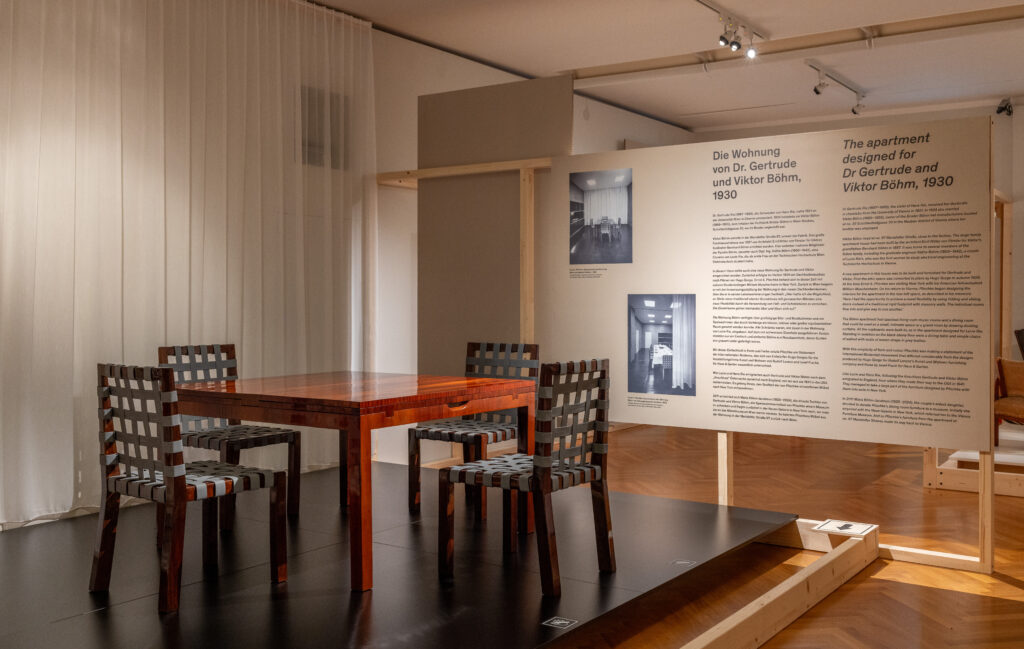The Vienna Furniture Museum, famous for its extensive collections of nineteenth-century Biedermeier and Thonet furnishings and other interior objects from the Habsburg era, broadened its curatorial scope this year to include Vienna’s role in twentieth-century modernism. The museum’s current exhibition, “Josef Frank and the Others: New Furniture 1920–1940,” focuses on the distinct Viennese Wohnkultur (dwelling culture) pioneered by the Austrian architect and designer Josef Frank (1885–1967) and his peers in the interwar period.
Frank and his colleagues reimagined the domestic interior as a place of relaxation, comfort, and seclusion from the bustle of urban life. The goal of furnishing a living room “is not to make it as luxurious as possible or as simple as possible, but rather to make it as comfortable as possible,” Frank wrote in 1927, two years after establishing his Haus & Garten furniture company. Furniture should be attractive and comfortable, combining historical elements with functionality and craftsmanship, according to Frank. At the same time, interiors should be casually arranged with juxtaposed colors and materials to create a warm and eclectic atmosphere.
Frank was the only Austrian architect invited by the modernist luminary Mies van der Rohe to design and furnish a model home at the seminal 1927 Deutscher-Werkbund “Dwelling” exhibition in Stuttgart. The upholstered wooden furnishings and colorful textiles from Haus & Garten stood in contrast to the austere interiors and tubular steel chairs in the other model homes designed by Mies, Marcel Breuer, and Mart Stam. The following year, the Austrian Werkbund appointed Frank to plan a similar housing exhibition outside Vienna, where the Wohnkultur ethos superseded the minimalist International Style as the prevailing mode of design in Austria.
Among the first displays in “Josef Frank and the Others” are the newly restored Haus & Garten furnishings from Bettina Kerner and Isidore Cohen’s living room, designed by Frank in the mid-1920s. “The furniture tells a love story,” the curator Eva Ottillinger recalled. Cohen was an English bank manager in Alexandria, Egypt, and met Kerner while vacationing in Bad Aussee, near Salzburg. After their marriage, Kerner ordered furniture from Haus & Garten to furnish their new Alexandria home.

Cohen’s two mahogany armchairs, nicknamed “Schnitzler” and “Stendal,” are reinventions of traditional models. The “Schnitzler” is a nod to the Windsor chair with an enclosed cane back and a thick, olive-green seat cushion. The “Stendal”—a low easy chair—has an air of sophistication with its rounded armrests, subtle cabriole legs, and vibrant ochre upholstery. Next to the “Schnitzler” sits the round “Butterfly” table, with three widely splayed legs inspired by the “Egyptian stool” popularized by the London department store Liberty in the late nineteenth century and later adopted by Adolf Loos and Frank for Viennese interiors.
Paired with the “Stendal” is a footstool whose original upholstery was unsalvageable and has been refurnished with a colorful floral pattern designed by Frank when he worked for Svenskt Tenn in Stockholm in the 1940s. The compatibility between Haus & Garten furniture from the 1920s and Svenskt Tenn textiles from the 1940s attests to how Frank’s Wohnkultur ethos later informed the design tenets of mid-century Swedish modernism.
The rest of the exhibition, dispersed over two floors and grouped by designer, features suites and individual furnishings by Felix Augenfeld, Henry Glass, Hugo Gorge, Walter Loos, Otto Prutscher, Ernst Plischke, and Robert Shelden. Gorge (1883–1934) was the creative director of Rudolf Lorenz’s Kunst und Wohnung company, the Viennese competitor of Frank’s Haus & Garten for elegant, modern, and functional furnishings.
Plischke (1903–92) was one of Frank’s most accomplished students, and he adopted a more unified and sober variation of the Wohnkultur attitude. The original living room and bedroom Plischke designed for the ceramicist Lucie Rie in 1928—with wall paneling, innovative built-in cupboards, and upholstered club chairs—is one of the museum’s most prized acquisitions.
Two years later, Plischke designed his signature ensemble for Gertrude and Viktor Böhm’s dining room. The radiant walnut table surrounded by rectilinear chairs with woven strips of gray leather for the seat and back is a statement of international modernism that combines the comfort of Haus & Garten and the luxury of Kunst und Wohnung with the minimalist ethos of the Bauhaus. The ensemble is displayed at the exhibition in isolation on a black ebony floor, exactly as it would have been seen in the Böhm’s dining room almost a century ago.

Many of the designers featured in the exhibition fled Austria as the political situation worsened before the German Anschluss in 1938. Frank immigrated to Sweden to design for Estrid Ericson’s Svenskt Tenn, and Plischke (who wasn’t Jewish) immigrated to New Zealand to protect his Jewish wife. Their Jewish clients were also at risk, and those who could pay the “Reich Flight Tax” fled with their possessions. Rie took her complete interiors to Hyde Park when she immigrated to London in 1938, while the Böhm family settled in New York with their Plischke dining set. The furnishings on display from the interwar period are wrapped up in these stories of exile and the furniture’s “long journey” back to Vienna.
Rie bequeathed her interiors to the Vienna Furniture Museum at the request of Plischke, who wanted “a key work of his early professional years” to be brought back to his native Vienna. The museum acquired the interiors after Rie died in 1995 and began the mammoth task of restoration. The descendants of Gertrude and Viktor Böhm in New York also donated Plischke’s dining table and woven-leather chairs to the museum in 2011 after the Neue Galerie in Manhattan passed on the offer. Similarly, the Cohens’ Haus & Garten living room, which had traveled from Alexandria to London in 1954, was acquired by the museum in 2010, after London’s Victoria & Albert Museum expressed little interest in securing the ensemble for its own collection.
The display of these masterpieces in “Josef Frank and the Others” enriches the historical narrative of the interwar decorative arts by emphasizing the significance of Viennese Wohnkultur as an alternative to the austerity of German modernism and the opulence of French Art Deco.















